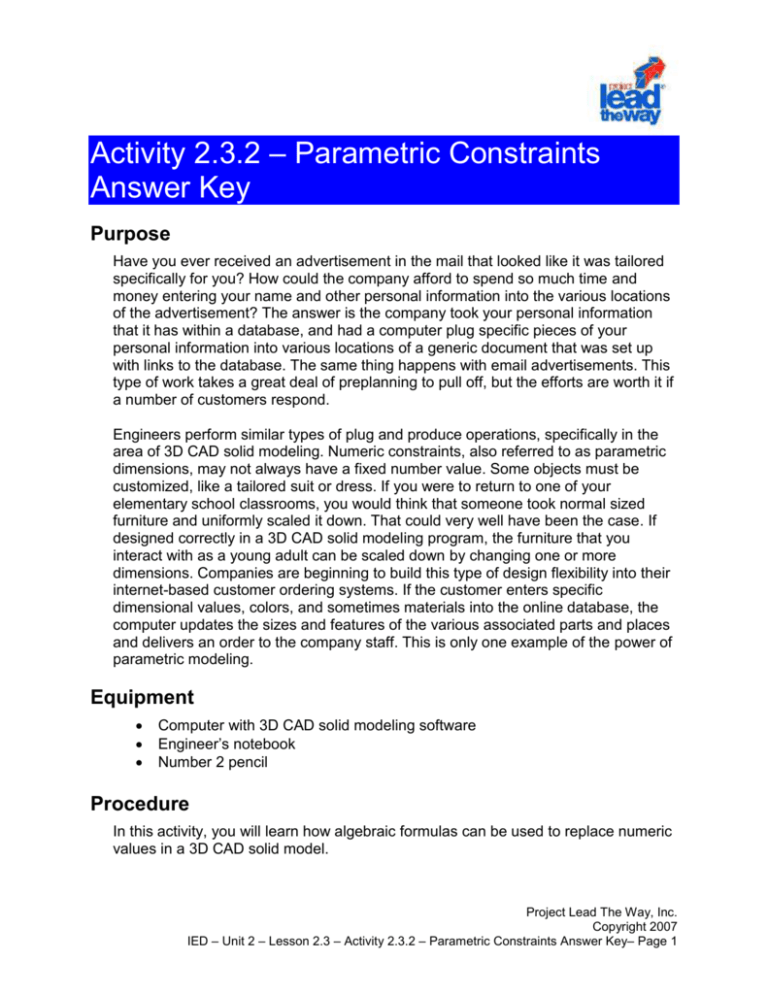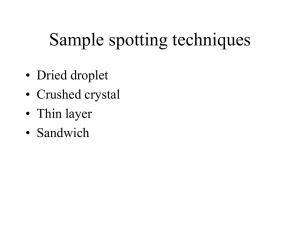Parametric Constraints in 3D CAD Modeling
advertisement

Activity 2.3.2 – Parametric Constraints Answer Key Purpose Have you ever received an advertisement in the mail that looked like it was tailored specifically for you? How could the company afford to spend so much time and money entering your name and other personal information into the various locations of the advertisement? The answer is the company took your personal information that it has within a database, and had a computer plug specific pieces of your personal information into various locations of a generic document that was set up with links to the database. The same thing happens with email advertisements. This type of work takes a great deal of preplanning to pull off, but the efforts are worth it if a number of customers respond. Engineers perform similar types of plug and produce operations, specifically in the area of 3D CAD solid modeling. Numeric constraints, also referred to as parametric dimensions, may not always have a fixed number value. Some objects must be customized, like a tailored suit or dress. If you were to return to one of your elementary school classrooms, you would think that someone took normal sized furniture and uniformly scaled it down. That could very well have been the case. If designed correctly in a 3D CAD solid modeling program, the furniture that you interact with as a young adult can be scaled down by changing one or more dimensions. Companies are beginning to build this type of design flexibility into their internet-based customer ordering systems. If the customer enters specific dimensional values, colors, and sometimes materials into the online database, the computer updates the sizes and features of the various associated parts and places and delivers an order to the company staff. This is only one example of the power of parametric modeling. Equipment Computer with 3D CAD solid modeling software Engineer’s notebook Number 2 pencil Procedure In this activity, you will learn how algebraic formulas can be used to replace numeric values in a 3D CAD solid model. Project Lead The Way, Inc. Copyright 2007 IED – Unit 2 – Lesson 2.3 – Activity 2.3.2 – Parametric Constraints Answer Key– Page 1 Project Lead The Way, Inc. Copyright 2007 IED – Unit 2 – Lesson 2.3 – Activity 2.3.2 – Parametric Constraints Answer Key– Page 2 Study the images on the previous pages, and table below. Use the given information to calculate the missing values. Create the object in a 3D CAD solid modeling program using the dimensions and parametric equations provided. The only numeric value that you should enter is 3 inches for dimension d0. When finished, identify the name and location of your CAD file. Project Lead The Way, Inc. Copyright 2007 IED – Unit 2 – Lesson 2.3 – Activity 2.3.2 – Parametric Constraints Answer Key– Page 3 Dimension Description Geometric Relationship Parametric Equation Value d0 Overall Plate Depth -- -- 3 in d1 Overall Plate Width d0*(5/3) 5 in d2 Plate Thickness d1/20 .25 in d3 Plate Taper Angle -- 0° d4 Slot Width d0/2 1.5 in d5 Slot Width Location d1*.8 4 in d6 Slot Depth Location d1/3 1 in d7 Slot Diameter d2*2 .5 in d8 Slot Extruded Length d2 .25 in d9 Slot Taper Angle d3 0° d10 Hole Width Location d1*.25 1.25 in d11 Hole Depth Location d0*.67 2 in d12 Hole Diameter d7 .5 in d8 .25 in d9 0° d13 d14 Hole Extruded Length Small Hole Taper Angle 5:3 ratio; overall plate width to overall plate depth 20 times smaller than the overall width perpendicular to the top and bottom plate surfaces ½ the overall plate depth 4/5 of the overall plate width 1/3 of the overall plate depth two times the plate thickness same as the plate thickness same as the plate taper angle ¼ of the overall plate width 2/3 of the overall plate depth same as the slot diameter same as the slot height Same as the slot taper angle CAD file name and location: Model the Arbor Press Cover Plate in a 3D CAD solid modeling program. You will need to use geometric constraints to limit the number of parametric dimensions that Project Lead The Way, Inc. Copyright 2007 IED – Unit 2 – Lesson 2.3 – Activity 2.3.2 – Parametric Constraints Answer Key– Page 4 are needed. Test your results by scaling the object up or down. If all of the parametric equations are written correctly, the object should increase or decrease in size and maintain its geometric proportions. When finished, save the file and identify its name and location in your student folder. Example Sketch of an Arbor Press Part CAD file name and location: Dimension d3 d9 d10 Description Plate Taper Angle Extruded Hole Lengths Hole Taper Angles Taper Angles and Hole Extrusion Length Dimensions Dimension Description Geometric Relationship Parametric Equation Value d0 Plate Width -- -- 1 in Project Lead The Way, Inc. Copyright 2007 IED – Unit 2 – Lesson 2.3 – Activity 2.3.2 – Parametric Constraints Answer Key– Page 5 d1 Plate Height d2 Plate Depth d3 Plate Taper Angle Hole 1 & 4 width location Hole 2 & 3 width location Hole 1 & 2 height location Hole 3 & 4 height location Diameter of the holes Extrusion length of the holes d4 d5 d6 d7 d8 d9 Twice the Plate Width 37% of the Plate Width perpendicular to the front plate surface 87.5% of the Plate Width 12.5% of the Plate Width 87.5% larger than the Plate Width Identical to Hole 2 & 3 width location 17.2% of the Plate Width Identical to the Plate Depth d0*2 2 in d0*.37 .37 in -- 0° d0*.875 .875 in d0*.125 .125 in d0*1.875 1.875 in d5 .125 in d0*.172 .172 in d2 .37 in Identical to the Plate Taper d3 Angle Example Cover Plate Parametric Table Taper angles of the holes d10 0° Conclusion 1. What is the difference between a numeric and a geometric constraint? A numeric constraint is a location or size dimension that is used on a geometric figure, and can be identified as a numeric value or a parametric equation. A geometric constraint is an assigned relationship that governs the orientation of two sketched elements with respect to each other. Examples of geometric constraints include collinear lines, concentric arcs or circles, parallel lines, perpendicular lines, and fixed points. 2. What advantages are there to using parametric equations instead of numeric values? A parametric equation will maintain a constant geometric relationship between two or more dimensional characteristics of an object. If a dimensional value changes, the parametric equations will automatically change any associated dimensional characteristics, thus maintaining proportionality. Parametric dimensions in a solid CAD model can be linked to spreadsheet programs that are capable of performing more complex mathematical operations. The product of these operations will update the model and all of its associated working drawings. Project Lead The Way, Inc. Copyright 2007 IED – Unit 2 – Lesson 2.3 – Activity 2.3.2 – Parametric Constraints Answer Key– Page 6 3. What disadvantages are there to using parametric equations for numeric values? Extensive knowledge of the geometric relationships that exist between an object’s features must be understood and identified before the object is generated as a CAD model. This requires a time investment that is not required when using only numeric values. Not all objects experience the types of changes that make the use of parametric equations an efficient alternative. Project Lead The Way, Inc. Copyright 2007 IED – Unit 2 – Lesson 2.3 – Activity 2.3.2 – Parametric Constraints Answer Key– Page 7








